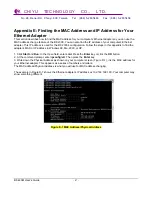
CHIYU TECHNOLOGY CO., LTD.
No.28, Renai Rd., Chiayi, 600, Taiwan Tel
:
(886) 5-2835460 Fax
:
(886) 5-2835458
BF-480M User’s Guide
- 44 -
DDNS
(
D
ynamic
D
omain
N
ame
S
ystem) - Allows a network device with a dynamic Internet IP address to have a
fixed host and domain name, such as
myhostname.mydomainname.com
. It is useful when you are hosting your
own website, FTP server, or other server behind a router, so people can find your site no matter how often the
Internet IP address changes. Using DDNS requires registering with a DDNS service provider on the Internet.
DHCP
(
D
ynamic
H
ost
C
onfiguration
P
rotocol) - A protocol that lets network administrators centrally manage and
automate the assignment of Internet Protocol (IP) addresses in an organization's network. Using the Internet’s
set of protocol (TCP/IP), each machine that can connect to the Internet needs a unique IP address. When an
organization sets up its computer users with a connection to the Internet, an IP address must be assigned to
each machine. Without DHCP, the IP address must be entered manually at each computer and, if computers
move to another location in another part of the network, a new IP address must be entered. DHCP lets a network
administrator supervise and distribute IP addresses from a central point and automatically sends a new IP
address when a computer is plugged into a different place in the network. DHCP uses the concept of a “lease” or
amount of time that a given IP address
will be valid for a computer. The lease time can vary depending on how long a user is likely to require the
Internet connection at a particular location. It’s especially useful in education and other environments where
users change frequently. Using very short leases, DHCP can dynamically reconfigure networks in which there
are more computers than there are available IP addresses. DHCP supports static addresses for computers
containing Web servers that
need a permanent IP address.
DNS
- The Domain Name System (DNS) is the way that Internet domain names are located and translated into
Internet Protocol (IP) addresses. A domain name is a meaningful and easy-to-remember “handle” for an Internet
address.
Domain
- A sub network comprised of a group of clients and servers under the control of one security database.
Dividing LANs into domains improves performance and security.
Firmware
- Code that is written onto read-only memory (ROM) or programmable read-only memory (PROM).
Once firmware has been written onto the ROM or PROM, it is retained even when the device is turned off.
Full Duplex
- The ability of a device or line to transmit data simultaneously in both directions.
Gateway
– A device that interconnects networks with different, incompatible communications protocols.
Half Duplex
- Data transmission that can occur in two directions over a single line, but only one direction at a
time.
Hardware
- Hardware is the physical aspect of computers, telecommunications, and other information
technology devices. The term arose as a way to distinguish the “box” and the electronic circuitry and
components of a computer from the program you put in it to make it do things. The program came to be known
as the software.
Hub
- The device that serves as the central location for attaching wires from workstations. Can be passive,
where there is no amplification of the signals; or active, where the hubs are used like repeaters to provide an
extension of the cable that connects to a workstation.
HTTP
(
H
yper
T
ext
T
ransport
P
rotocol) - The communications protocol used to connect to servers on the World
Wide Web. Its primary function is to establish a connection with a Web server and transmit HTML pages to the
client browser.




































